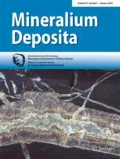Abstract
The Géant Dormant gold mine is a sulfide-rich quartz vein gold deposit hosted by a volcano-sedimentary sequence and an associated felsic endogenous dome and dikes. The auriferous quartz-sulfide veins were preceded by two synvolcanic gold-bearing mineralizing events: early sulfidic seafloor-related and later disseminated pyrite in the felsic dome. This deposit differs from classical Archean auriferous quartz vein deposits by the low carbonate and high sulfide contents of the veins and by their formation prior to ductile penetrative deformation. The δ18O values of quartz associated with seafloor-related auriferous sulfides average 11.9 ± 0.6‰ (n = 3). The seafloor hydrothermal fluids had a δ18O value of 3.2‰ calculated at 250 °C. The oxygen isotope composition of quartz and chlorite from veins average 12.5 ± 0.3‰ (n = 20) and 5.9 ± 1.1‰ (n = 4) respectively. Assuming oxygen isotope equilibrium between quartz and chlorite, the veins formed at a temperature of ∼275 °C, which is consistent with the calculated temperature of 269 ± 10 °C from chlorite chemistry. The gold-bearing fluids had a δ18O value of 4.7‰ calculated at 275 °C. The δ34S values of sulfides from the three gold events range from 0.6 to 2.8‰ (n = 32) and are close to magmatic values. Sulfur isotope geothermometry constrains the sulfide precipitation in the gold-bearing veins at a temperature of ∼350 °C. The similarity of the isotope data, the calculated δ18O of the mineralizing fluids and the likely seawater fluid source suggest that the three mineralizing events are genetically related to a volcanogenic hydrothermal system. The high value of the auriferous fluids (δ18O = 4.7‰) is attributed to a significant magmatic fluid contribution to the evolved seawater-dominated convective hydrothermal system. The two-stage filling of veins at increasing temperature from quartz-chlorite (275 °C) to sulfides (350 °C) may reflect the progressive maturation of volcanogenic hydrothermal systems. These results, together with field and geochemical data, suggest that formation of gold-rich volcanogenic systems require specific conditions that comprise a magmatic fluid contribution and gold from arc-related felsic rocks, coeval with the mineralizing events. This study shows that some auriferous quartz-vein orebodies in Archean terranes are formed in volcanogenic rather than mesothermal systems.
Similar content being viewed by others
Author information
Authors and Affiliations
Additional information
Received: 12 December 1998 / Accepted: 5 July 1999
Rights and permissions
About this article
Cite this article
Gaboury, D., Daigneault, R. & Beaudoin, G. Volcanogenic-related origin of sulfide-rich quartz veins: evidence from O and S isotopes at the Géant Dormant gold mine, Abitibi belt, Canada. Mineral. Deposita 35, 21–36 (2000). https://doi.org/10.1007/s001260050003
Issue Date:
DOI: https://doi.org/10.1007/s001260050003




